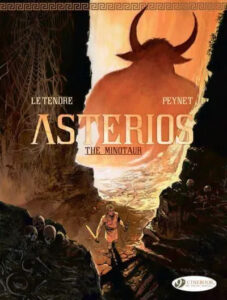By Le Tendre & Peynet
Publisher: Cinebook
ISBN: 9781800441156
I had absolutely no idea that the minotaur from Greek mythology had a name. Serge Le Tendre did, and his fascination for the Greek tales has captivated his imagination since childhood. This fascination led him to read the stories in depth and discover details that aren’t typically known in the more general, abridged, sanitised versions that we know. Seeing Asterios as a tragic individual, cursed by his appearance, Le Tendre decided to write a version of the story that puts him at the heart of the story, not as a terrible beast, but as a child and, later, a young man, trying to cope with the way he looks.
The story begins with Daedalus being forced to flee Athens after the accidental death of his nephew. He sails to Crete where Minos and his brothers are in conflict over who should rule. Minos has made a deal with Poseidon whereby the god will send a bull from the ocean’s depths to the shore to prove Minos is chosen by the gods and, in return, Minos must sacrifice the bull. Daedulus watches the bull emerge, and Minos be proclaimed king, but the new ruler opts not to slaughter it but to add it to his herd instead. Angry, Poseidon causes Pasiphaë, Minos’s wife, to lust after the bull. She demands Daedalus build a wooden cow to trick the bull into mounting it while she hides inside – and falls pregnant as a result.
Horrified by the child’s appearance, the baby is sent to be nursed by Daedalus’s wife, Naucrate, where he grows to childhood largely hidden from the outside world. Frustrated by his appearance, and showing violent tendencies, Daedalus does his best to raise Asterios well and guide his emotions. But it’s not enough to prevent bloodshed, and those deaths lead directly to the creation of the legendary labyrinth.
Le Tendre has deliberately set out to show Asterios in a sympathetic light – the character narrates the story of much of his past while showing restraint and consideration to Theseus. And it works too. Perhaps the crowning glory is Peynet’s artwork which lifts the tale to new heights in his depiction of the classical world.
This is a one-off tale rather than a part of a series, and perhaps that’s a good thing. As a concept, it works incredibly well, but repeating the formula would diminish its impact. Although I confess, it’s left me hungry to learn more about these ancient stories.
And if you liked that: Green Manor, also from Cinebook’s Expresso line, is well worth your attention.


No comments yet.